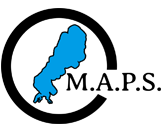Mullett Lake
Watershed: Mullett Lake Watershed
Primary Inflows: Indian River, Mullett Creek,
Pigeon River
Primary Outflows: Cheboygan River
Surface Area: 16,630 acres
Shoreline (in miles): 28 miles
Maximum Depth: 145 feet
Public Access Sites:
There are two Michigan Department of Natural Resources (DNR) public access sites on the lake,
along with several marinas.
Description:
Mullett Lake is a large, deep, high-quality lake with 200 billion gallons within its basin. It is part of northeast Michigan’s Inland Waterway and is the state’s fifth largest lake, with a surface area of 16,630 acres. Tributaries of Mullett Lake include: Indian River, Little Sturgeon, Mullet Creek and East Little Pigeon. Mullett Lake lies within six different townships: Aloha, Benton, Inverness, Koehler, Mullett, and Tuscarora.
Mullett Lake is a popular lake for recreationists and supports activities such as fishing, boating, kayaking, canoeing, and swimming. During the summer months, the local population can increase three-fold with tourists and seasonal residents.
Primary Inflows: Indian River, Mullett Creek,
Pigeon River
Primary Outflows: Cheboygan River
Surface Area: 16,630 acres
Shoreline (in miles): 28 miles
Maximum Depth: 145 feet
Public Access Sites:
There are two Michigan Department of Natural Resources (DNR) public access sites on the lake,
along with several marinas.
Description:
Mullett Lake is a large, deep, high-quality lake with 200 billion gallons within its basin. It is part of northeast Michigan’s Inland Waterway and is the state’s fifth largest lake, with a surface area of 16,630 acres. Tributaries of Mullett Lake include: Indian River, Little Sturgeon, Mullet Creek and East Little Pigeon. Mullett Lake lies within six different townships: Aloha, Benton, Inverness, Koehler, Mullett, and Tuscarora.
Mullett Lake is a popular lake for recreationists and supports activities such as fishing, boating, kayaking, canoeing, and swimming. During the summer months, the local population can increase three-fold with tourists and seasonal residents.
Known Aquatic Invasive Species:
Zebra mussels
Phragmites
Round goby
Eurasian watermilfoil
Monitoring and Research:
Mullett Lake is monitored every three years through the Watershed Council’s Comprehensive Water Quality Monitoring (CWQM) Program for dissolved oxygen, specific conductivity, pH, nitrate-nitrogen, total nitrogen, total phosphorus, and chloride levels.
Water transparency, chlorophyll-a, and water temperature are also monitored in Mullett Lake each summer by volunteers as part of the Watershed Council’s Volunteer Lake Monitoring (VLM) Program.
Zebra mussels
Phragmites
Round goby
Eurasian watermilfoil
Monitoring and Research:
Mullett Lake is monitored every three years through the Watershed Council’s Comprehensive Water Quality Monitoring (CWQM) Program for dissolved oxygen, specific conductivity, pH, nitrate-nitrogen, total nitrogen, total phosphorus, and chloride levels.
Water transparency, chlorophyll-a, and water temperature are also monitored in Mullett Lake each summer by volunteers as part of the Watershed Council’s Volunteer Lake Monitoring (VLM) Program.
Publications:
- Mullett Shoreline Survey Report (2016)
- Mullett Lake Profile (2009)
- Mullett Lake Shoreline Survey (2008)
- Mullett Lake Aquatic Plant Survey (2007)
- Mullett Lake Partial Aquatic Plant Survey - Summary (2015)
- Mullett Lake Tributary Monitoring Report (2008)
- Mullett Lake Watershed Plan (2002)
- Mullett Lake DNR Fisheries Update
- Mullett Lake Creel Survey
- 2011 Michigan DNR Walleye Survey
- Andreae/Banwell Nature Preserve
- Walleye Diet Study Instructions & Labels
- Walleye Diet Analysis Progress
- Mullett Lake Greenbelt Workshop Course Packet
|
Mullett Lake Area Preservation Society
Keeping Mullett Lake and its surrounding watershed healthy for generations to come! |
Please select your randomized shoreline number from the drop down in the "Shoreline ID Search" box below. Your randomized number was provided in the mail. Results for greenbelt score, Cladophora density, and erosion will appear by hitting 'apply.' A legend for each map layer is shown by clicking the arrow next to the checked layer. Scroll below the map for information on greenbelts, Cladophora, and erosion from the survey. Please do not hesitate to contact Mullett Lake Area Preservation Society (M.A.P.S.) or Tip of the Mitt Watershed Council for more information.
This project was made possible the Mullett Lake Area Preservation Society (MAPS) - an organization dedicated to the wildlife and resource preservation of Mullett Lake.
The purpose of MAPS is to represent the best interests of its members toward the pursuit of practical lake management to protect and preserve the material character and water quality of Mullett Lake and its surrounding watershed.
To learn more about MAPS, visit their website at mullettlake-maps.org
This project was made possible the Mullett Lake Area Preservation Society (MAPS) - an organization dedicated to the wildlife and resource preservation of Mullett Lake.
The purpose of MAPS is to represent the best interests of its members toward the pursuit of practical lake management to protect and preserve the material character and water quality of Mullett Lake and its surrounding watershed.
To learn more about MAPS, visit their website at mullettlake-maps.org




